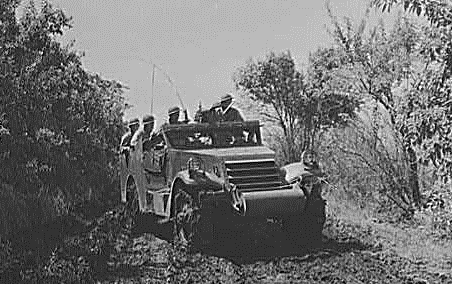
| Year | June 1939 |
| Vehicle Type | [@type] |
| Origin & Designer | [@designer] |
| Numbers Produced | 20.894 |
| Crew | 8 (Commander & Driver + Six Passengers) |
| Main Armament | 1 x .50 cal Heavy Machine Gun |
| Main Armament | [@sponson_traverse] |
| Elevation | [@elevation] |
| Turret Traverse | [@turret_traverse] |
| Gun Traverse | [@gun_traverse] |
| Gun Mount | [@gun_mounts] |
| Maximum Range | [@maximum_range] |
| Armour Penetration | [@armour_penetration] |
| Gun Sight | 5.62m |
| Secondary Armament | 2 x .30 cal M1919A4 Machine Gun (Skate Rail) |
| Smoke Discharger | [@smoke_discharger] |
| Ammunition Carried | 750 x .50 cal & 5000 x .30 cal |
| Height | 2.0m |
| Width | 2.0m |
| Length | 5.62m |
| Combat Weight | 5.620 kg |
| Ground Clearance | 0.40m |
| Fording Depth | 0.71m |
| Trench Crossing | 0.46m |
| Obstacle Clearance | 0.30m |
| Climbing Ability | 31° |
| Radio | SCR 506/508/510 |
| Armour | Upper Hull Front: 13mm. Lower Hull Front: 6.4mm. Upper Hull Sides: 6.4mm. Lower Hull Sides: 6.4mm. Hull Rear: 6.4mm. Hull Top: Open. Hood Top: 6.4mm. Hull Bottom: 6.4mm. |
| Engine | Hercules JXD (Petrol) |
| Transmission | 4 Forward & 1 Reverse |
| Maximum Road Range | 250 miles (400 km) |
| Maximum Cross Country Range | [@maximum_cross_country_range] |
| Maximum Water Range | [@maximum_water_range] |
| Maximum Road Speed | 55 mph (88 kph) |
| Maximum Cross Country Speed | 25 mph (40 kph) |
| Maximum Water Speed | [@maximum_water_speed] |
| Variants | [@variants] |
| Notes | The US military required a light wheeled armoured vehicle for use in their new mechanised cavalry units. This was to act as a scout vehicle in the reconnaissance units. After trials the M3 was adopted for this role and the improved M3A1 was introduced in 1940. The M3A1 provided good mobility and could carry a crew of two plus up to six in the open fighting compartment. It could mount up to three or more machine guns which ran on a skate rail. It was protected by armour ranging from 6.4mm to 13mm. One of the main draw backs was the lack of rear doors. The US 7th cavalry brigade was the first unit to be supplied with the M3 with the army deciding on the M3A1. The M3A1 Scout car was used in the early stages of World War Two, but with the increasing numbers of half-tracks available it was soon relegated to a rear echelon role, many were also issued to allied armies. |